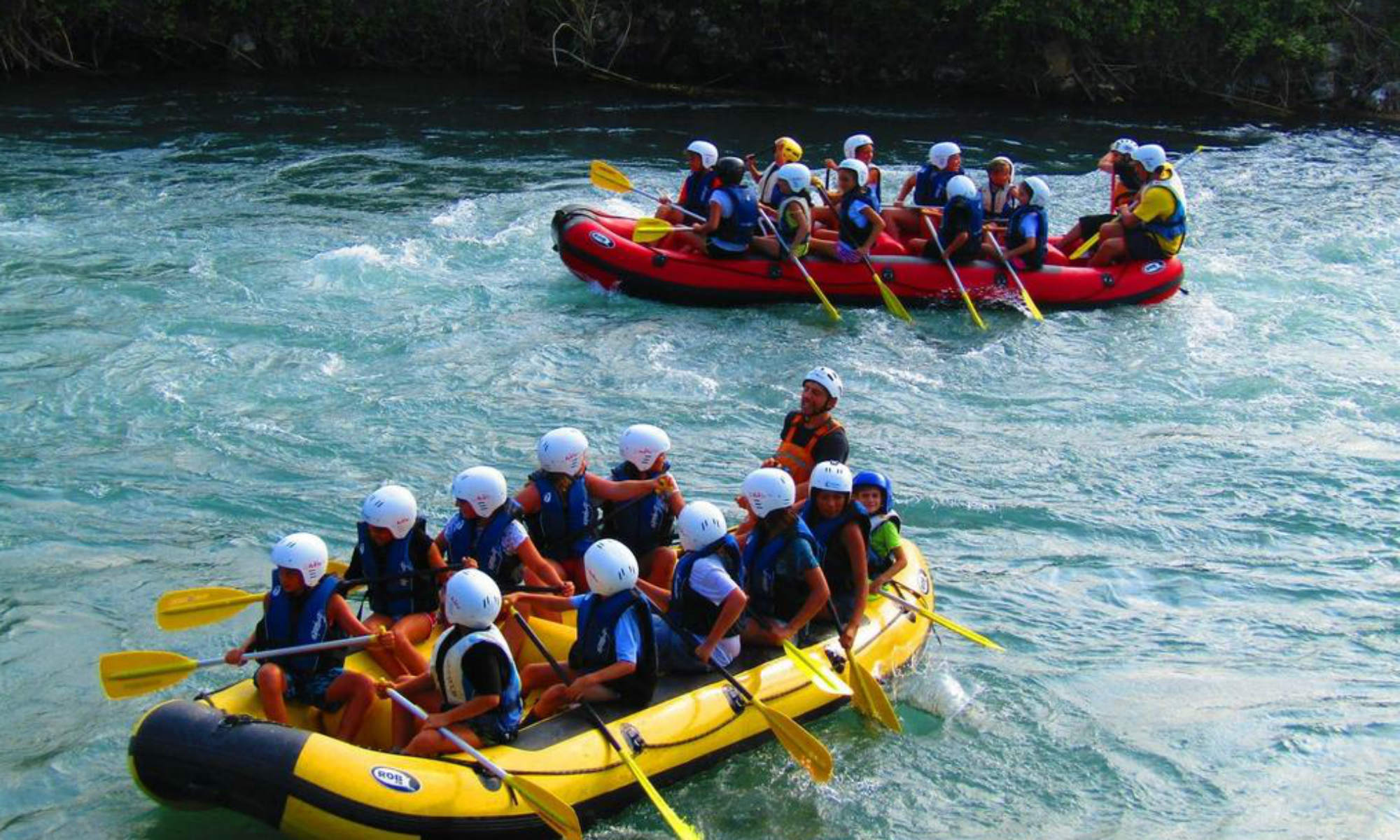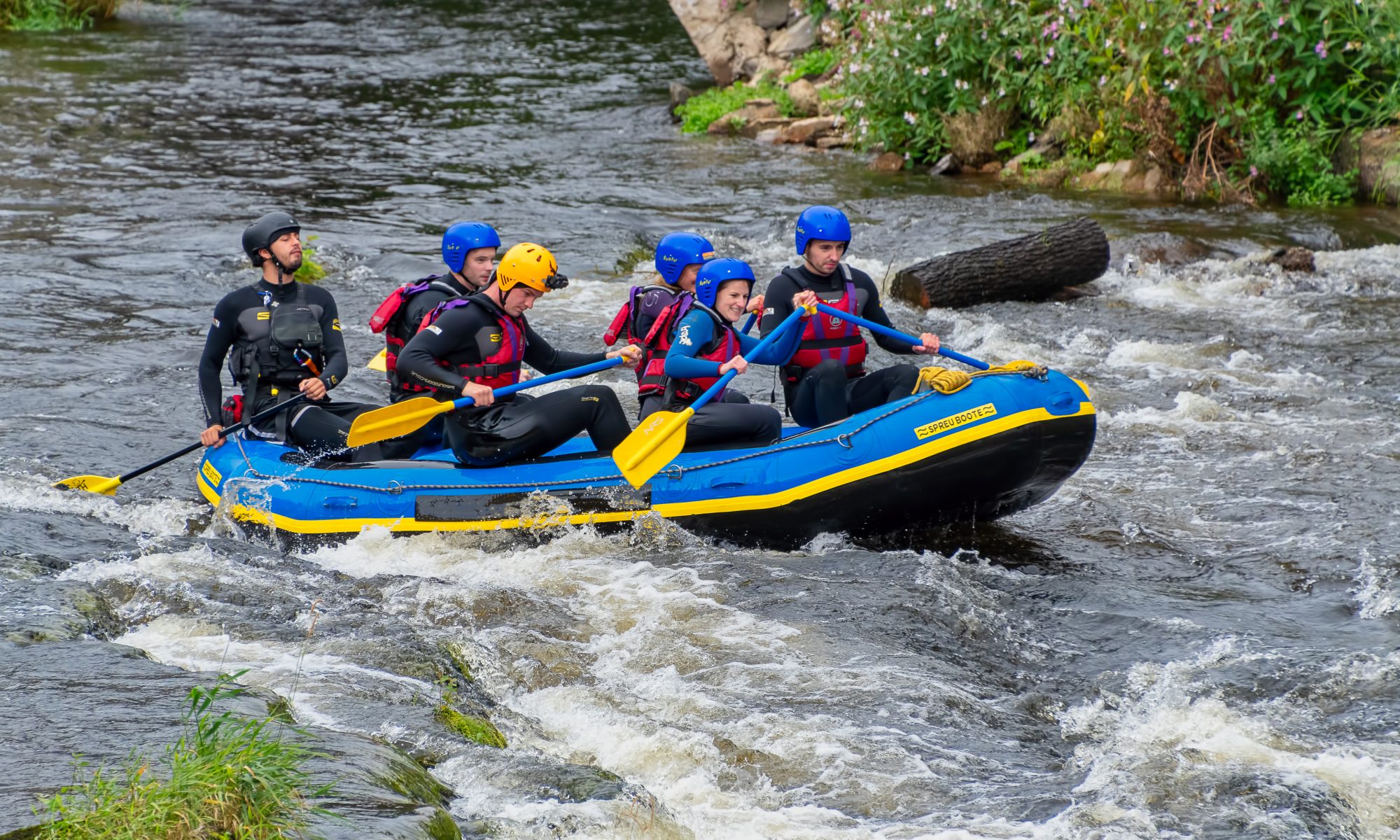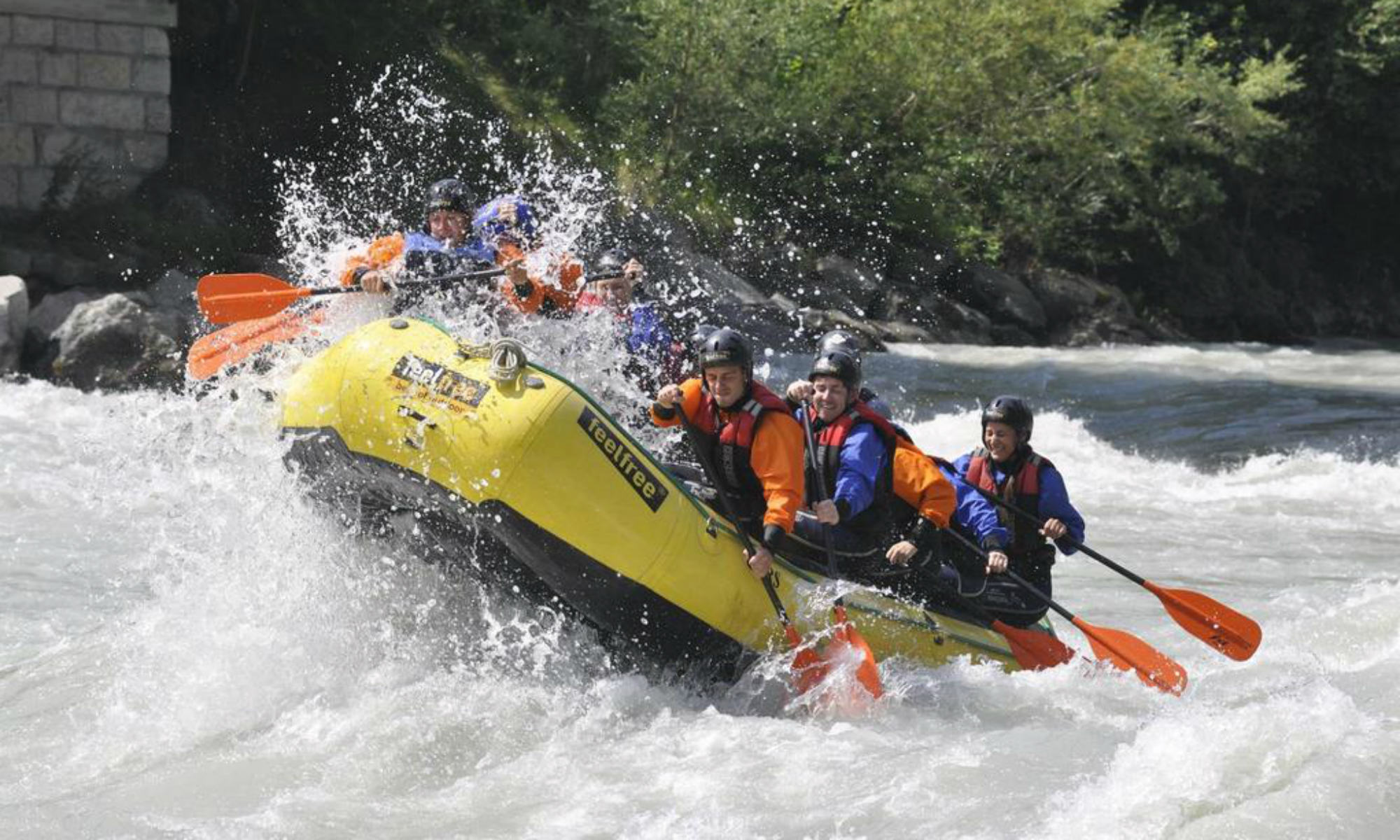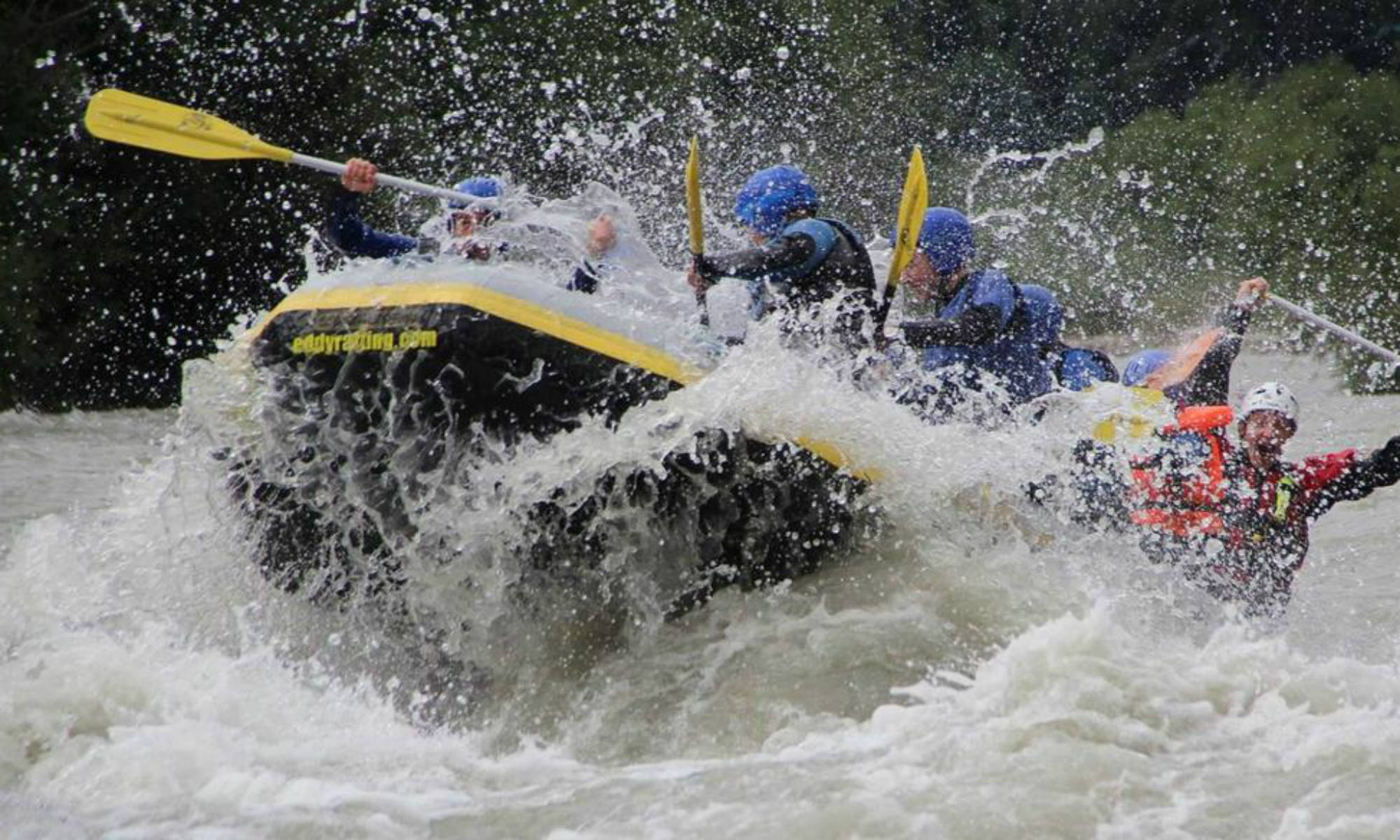Emerald green streams, rousing waves, and picturesque riverscapes – the outdoor activity of white water rafting is ideal for all nature lovers and (soon-to-be) adventure sports enthusiasts. Rafting requires coordination and team spirit – those who have already sat in a rubber raft with their companions and fought against the primal force of the water, will certainly not forget this experience any time soon. This is why white water rafting tours are becoming more and more popular, not only with families and groups of friends but also for team building events and stag and hen parties.
The expert team at checkyeti has gathered everything you need to know about white water rafting, which requirements there are and where the best places to go white water rafting are located.
-
- What is white water rafting?
- White water rafting, water rafting or river rafting – one sport, many terms
- Who can go rafting?
- What’s the best time to go rafting?
- What are the requirements to go rafting?
- Which grades of difficulty exist?
- What are the best places to go white water rafting in Europe?
- What does a typical rafting tour look like?
- Which equipment is needed?
- Safety first – what to pay attention to when rafting?
What is white water rafting?
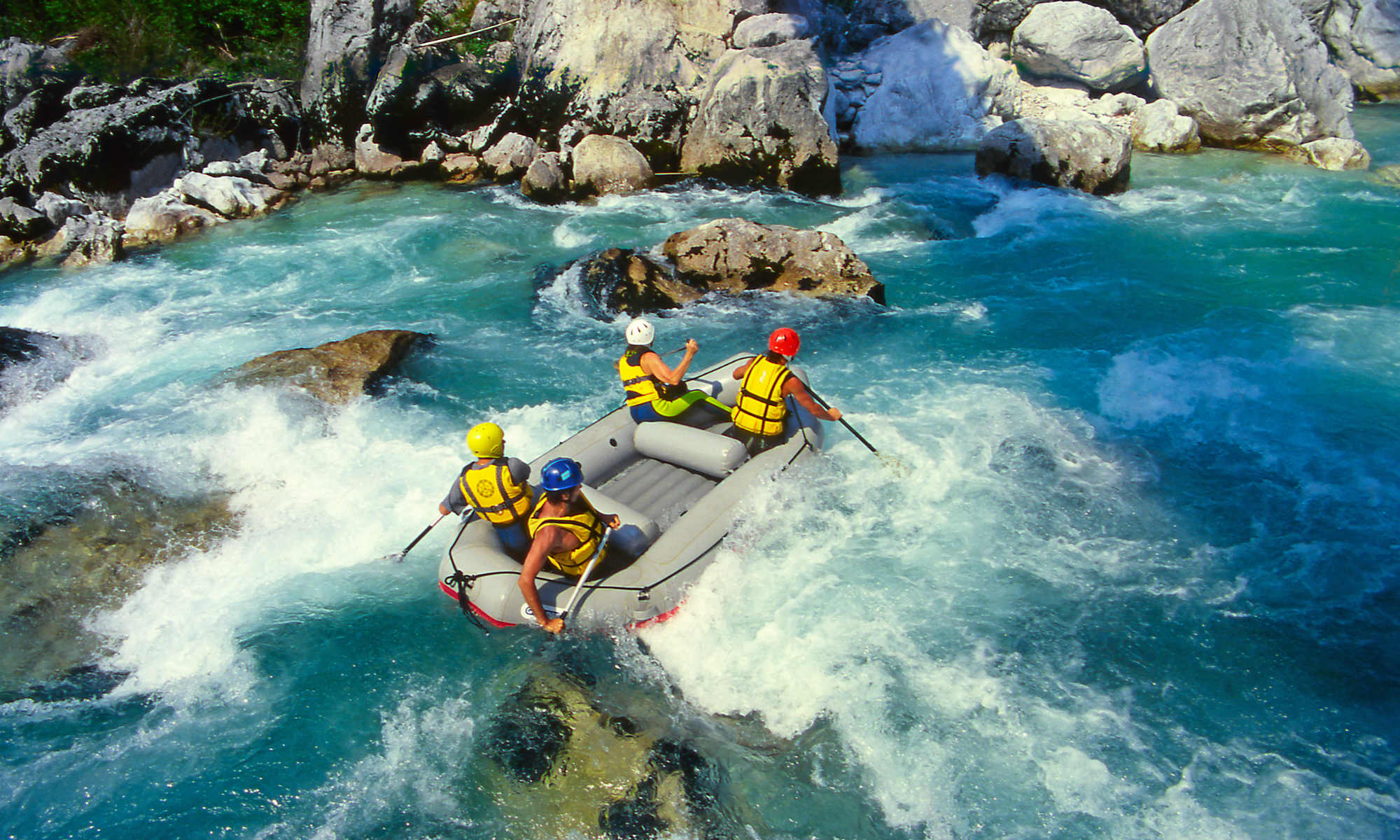
Rafting is a white water sports activity that has grown in popularity, especially in Central Europe, since the 80s. While in the beginning, rafts were made of wood, the boats used today come in the form of a rubber dinghy and are used to traverse along white water rivers and other bodies of water. Depending on the course of the river, white water rapids of varying degrees of difficulty are mastered along the way. Rafts are made of several layers of robust rubber to allow them to come into contact with stones and rocks without breaking. The size of the boats varies between 3 and 6 m, and, dependent on their length, they are suited for different group sizes. Typically, boats can hold between 2 and 20 people.
The participants of the white water rafting tour steer the boat using single-bladed paddles, while experienced and certified rafting guides accompany them and offer support where needed. Rafting is indeed a sociable outdoor activity that combines fun, action and sports all in one, with the added bonus of it taking place in striking natural landscapes. Roaring white water rivers, picturesque mountain panoramas and thrilling rapids turn every rafting tour into a true adventure.
White water rafting, water rafting or river rafting – one sport, many terms

There are several ways of referring to this sport: from white water rafting to water rafting or river rafting. Generally speaking, they all refer to the same type of activity. While in the US and in other countries, people sometimes use the term wild water rafting, the terms white water rafting and water rafting are more common, especially in the UK. Furthermore, people in Switzerland, often speak of river rafting.
It is important to differentiate between rafting on natural bodies of water and rafting on man-made bodies of water. Natural bodies of water are, for example, rivers and streams which, if they have a significant number of rapids, are considered to be white water. White water gets its name from the fact that when there is sufficient downhill gradient and a significant number of narrow straits, the water cannot flow evenly. This causes the water to absorb air and the frothing water appears white.
When it comes to man-made bodies of water, rafting can be undertaken in specifically designed white water arenas. In these white water installations, water is pumped into white water canals which resemble natural rapids. The force of the water and therefore the level of difficulty can be set individually, which means that these arenas are ideal for training and for competitions.
Who can go rafting?
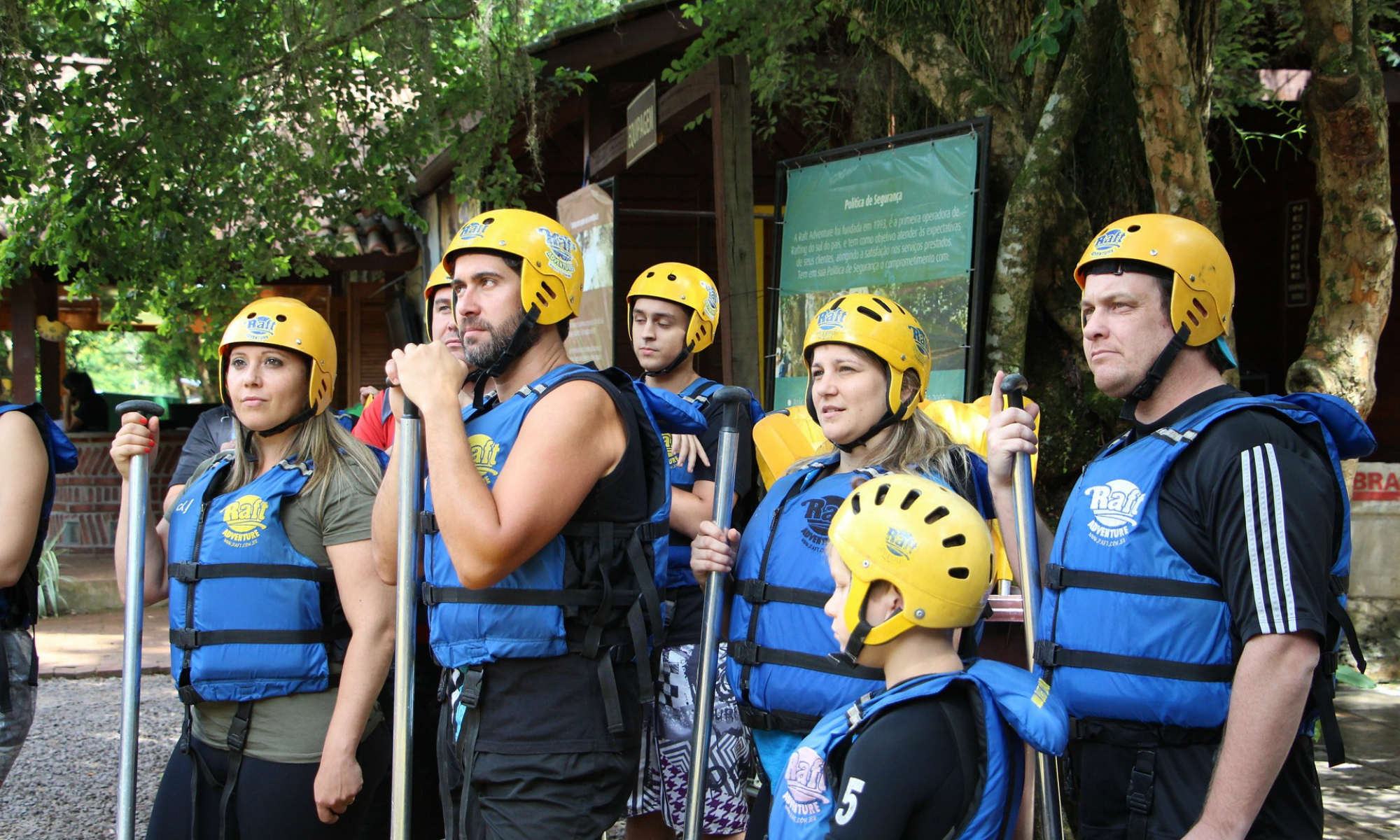
Since very little prior experience is needed, white water rafting is ideal for families and groups with different physical abilities. Depending on the difficulty level of the river, participants should have basic swimming skills. In addition, it is required that all people who want to join a white water rafting tour are in overall good health.
Most rafting providers offer rafting tours at various difficulty levels (easy – medium – challenging). That way, anyone, from beginner to adrenaline junkie, can find the most appropriate white water rafting tour which suits their wishes and experience. Even families with small children will find suitable rafting tours in most regions. In general, children aged 5 and upwards are allowed on board easier rafting tours with calmer straits.
Rafting is a perfect group activity – the longest rafts can hold up to 20 people, making it easy for large groups of friends to plunge into their white water rafting adventure together. One of the things that makes white water rafting so much fun is the fact that it really requires people to work together. As such, the sport has, over the years, become a popular choice for team building events for pupils and for work colleagues. The challenge of white water rafting really binds people together, allowing them to make unique and unforgettable memories of their manoeuvres through wild rapids together.
Nonetheless, those who are seeking a white water rafting adventure by themselves or in pairs will also find the right offer with most providers. Beside offers for entire groups, most rafting centres typically offer open tours as well, which, depending on the size of the boat, different numbers of people can take part in. Most white water rafting tours start with a minimum of 4 participants.
Since white water rafting has different levels of difficulty, most rafting centres offer a broad selection of different types of tours for every occasion. These can be upgraded by booking additional services such as barbecues. Because of these special offers, white water rafting tours are becoming increasingly popular activities for stag or hen parties. Some providers even incorporate fun games and costumes into these types of rafting tours. After an adventurous afternoon on the white water river, the bride/groom-to-be can enjoy a relaxed evening with their friends by having a barbecue or a few drinks at the base camp’s own bar.
What’s the best time to go rafting?
The best time to go rafting varies, depending on where you go. In the UK, for example, white water rafting is an all-year-round activity. Naturally, the temperature of the water will be colder in winter than in summer, but that doesn’t stop rafting enthusiasts from getting their fix of white water adventures. For those seeking to go rafting on the European mainland, the best time to go is from the beginning of April to the end of October. As soon as the snow caps in the Alps begin to melt and the rivers are filled with enough water, white water rafters will find the best conditions. Even after longer periods of rain, the conditions for white water rafting are ideal.
In more southern regions, the white water rafting season starts a few weeks earlier than in the alpine regions. However, in places like Austria or Switzerland, rafting tours can be booked in autumn as well. In any case, it is important to keep in mind that during the hot summer months and after long periods without rain, it can happen that rivers don’t have enough water for rafting tours to take place.
What are the requirements to go rafting?
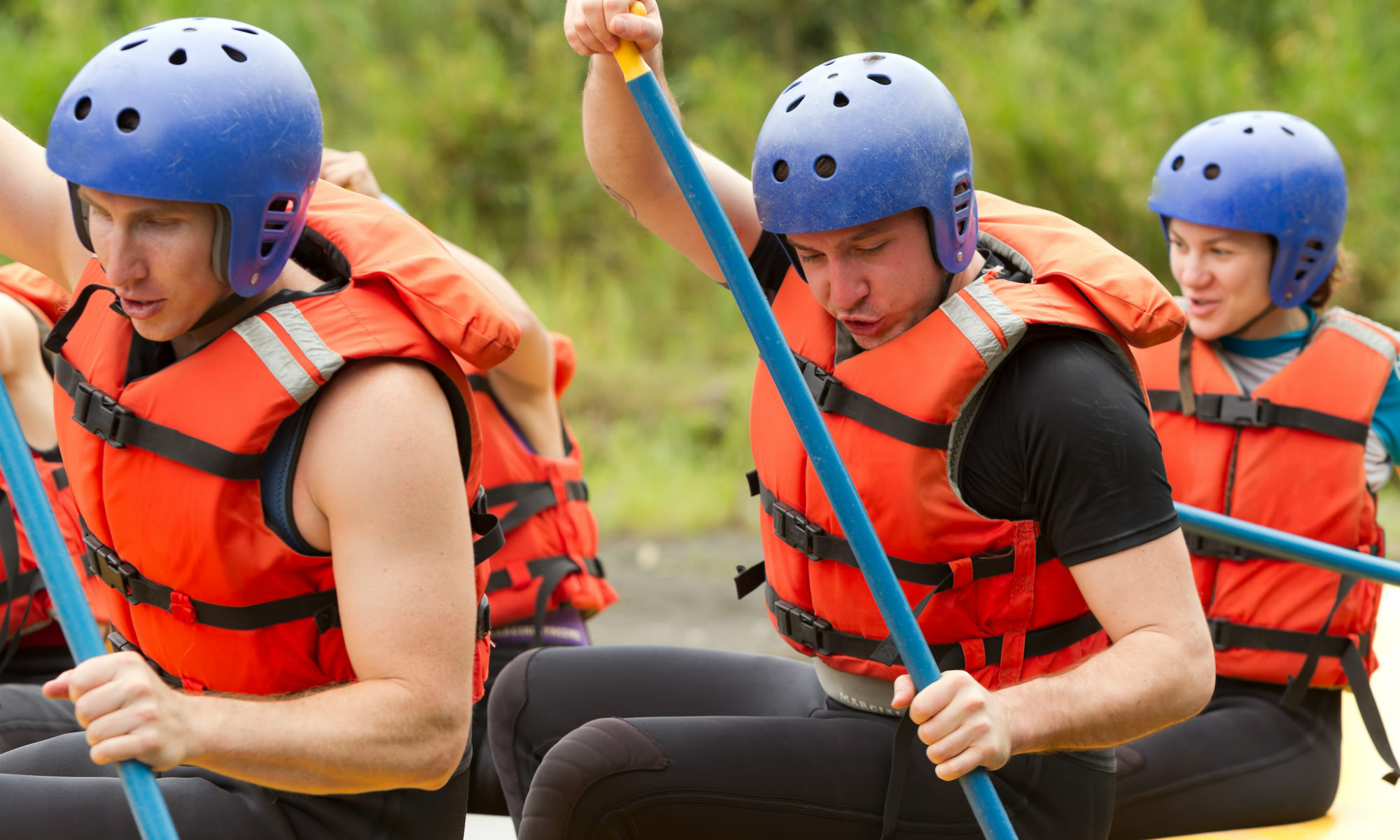
White water rafting is a sport that novices can easily partake in. At the beginning of every white water rafting tour, the rafting guide briefs all the participants and explains what the course of events will look like. Most providers offer tours for beginners and the more advanced so that everyone can find their ideal rafting adventure.
Depending on which river or which rafting route is selected, different physical abilities are prescribed. All participants of a white water rafting tour should be in overall good health and possess a basic level of fitness, as they are always in motion. White water rafting requires people to use, in particular, their arm, upper body and leg muscles, in order to carry or steer the raft or to keep their own body in position while inside the raft. Adults who weigh more than 125kg/275lbs should let the provider know beforehand, as this can result in the maximum amount of people per raft being reduced.
Even though most white water rafting tours require participants to also have good swimming skills, children who are not yet the most confident swimmers can still join in on some easier sections of certain tours. In any case, wearing a helmet and a life jacket is mandatory when rafting, as it ensures that children and other people who may not be the best of swimmers are able to participate. It is important, however, that young children are accompanied by a more experienced and physically strong adult as well as by a professional guide who can keep the raft under control at all times. Most providers allow children from the age of 5 to join a rafting tour, given the aforementioned provisions. It is, however, important to clarify beforehand, whether the provider can offer a wetsuit that fits the child.
If a white water rafting tour takes place on a more challenging river, it is imperative that all participants are good swimmers and that they are not afraid of the water. It can always happen that one gets very wet or that one falls out of the raft when manoeuvring over rough waves and past natural impediments. In situations like these, it is important not to panic and to stay calm. The rafting guide is trained exactly for these types of situations and will help anyone who goes overboard back onto the boat.
Which grades of difficulty exist?
Rivers are classified on the basis of how challenging they are to raft on. The International Scale of River Difficulty, published by the American Whitewater Association, defines 6 classes (or grades) of difficulty which range from Class I – ‘Easy’, to Class VI – ‘Extreme and Exploratory Rapids’. Depending on the classification of the river in question, white water rafting tours are assigned different levels of difficulty. Beginners’ rafting tours usually take place on rivers classified I to II. More experienced people enjoy white water rafting on rivers classified III to V. Rivers in Class VI are mostly avoided, even by professionals, as they are widely considered unsafe.
Most rivers can be divided into a number of sections with varying grades of difficulty. This means that when doing research on the difficulty level of a certain river, one will usually come across a range of different grades (e.g.: Classes II-IV). Nonetheless, the guides make sure that white water rafting tours only take place on those sections suitable for the experience level of the participants.
Scale of River Difficulty
| Class | Conditions |
|---|---|
| I | Weak riffles and waves with easily avoidable obstacles in the water. Low risk for swimmers. |
| II | Wide channels with clear visibility and straightforward rapids. Several rocks and medium-sized waves that can easily be navigated around with the right paddling technique. |
| III | Moderately sized and irregular waves along the rapids which cannot always be avoided. Tight passages and fast currents require the ability to keep the boat stable. On occasion, larger waves can appear, but they can typically be navigated around with relative ease. In rivers with large volumes of water, powerful currents and strong eddies can be present. Inexperienced parties are recommended to scout the rivers first. |
| IV | Rapids are powerful and intense, but relatively predictable. Waves can be large and unavoidable while passages may be somewhat restricted. As such, precise handling of the boat is required and fast manoeuvres under pressure are often necessary. |
| V | Rapids are very long, obstructed and violent, thereby exposing paddlers to a certain level of risk and requiring a high level of fitness. Drops are likely to contain large waves and holes, while eddies tend to be small, turbulent and hard to reach. |
| VI | Very few attempts to raft along these rivers. The levels of danger are quite high and the consequences of error are severe. Hence, these rivers are only recommended for teams of experts after a thorough inspection. |
*Source: American Whitewater Association
What are the best places to go white water rafting in Europe?
For many rafting enthusiasts, a certain destination is considered to be a true white water rafting hotspot if it possesses a combination of winding rivers, crystal clear water and stunning landscapes. These can typically be found in mountainous and glacial regions where rivers are filled with fresh meltwater in spring, thereby creating ideal conditions for white water rafting. In the UK, the most popular natural rivers on which to go white water rafting are located in North Wales and Scotland. On the European mainland, alpine countries such as Austria, France and Switzerland as well as several more southern countries – i.e. Croatia, Slovenia, Spain and Italy are home to some of the most scenic white water rivers and are therefore widely regarded as being true hotspots for white water rafting.
White water rafting in the UK
White water rafting in Wales
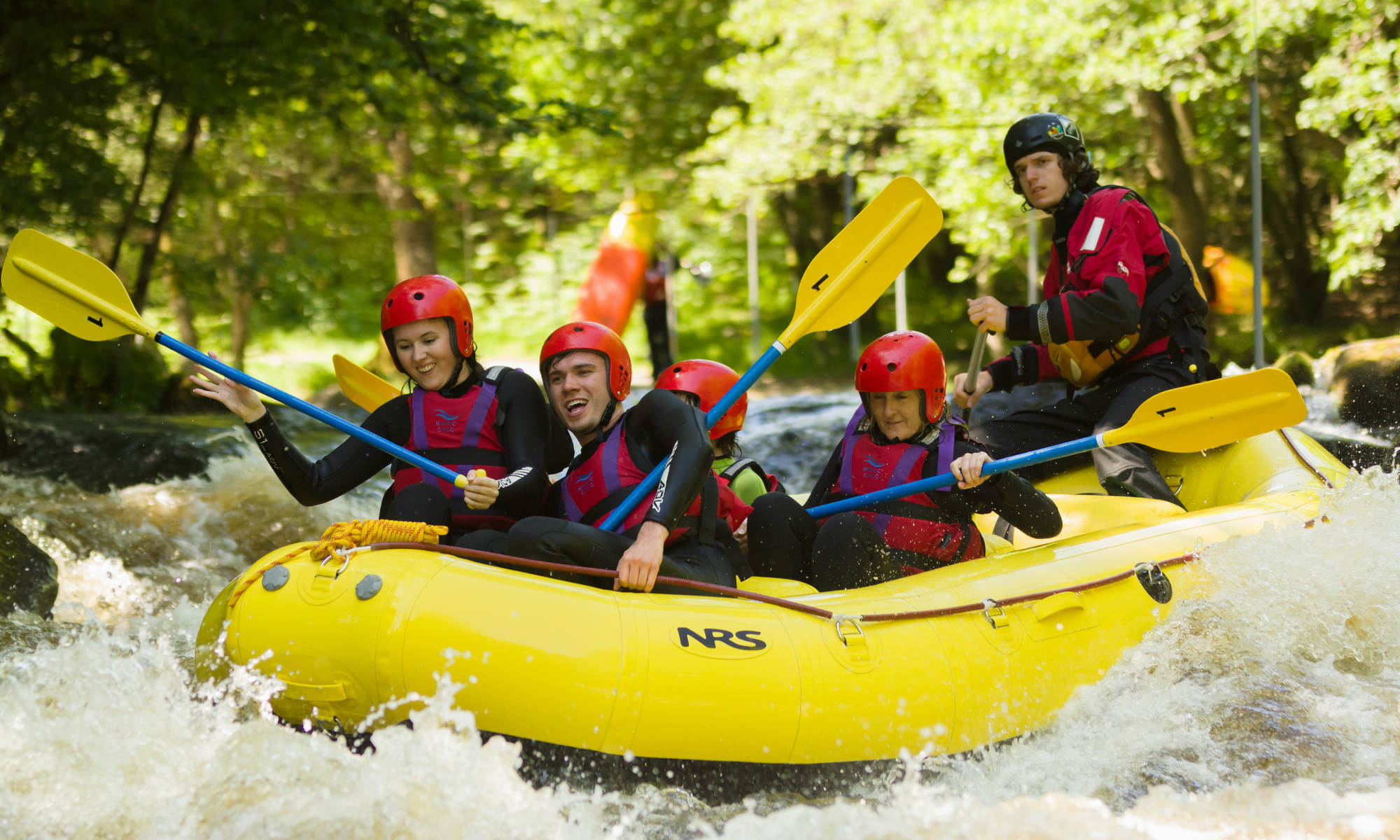
White water rafting in the UK promises to be a fun, action-packed adventure. Those who wish to go white water rafting in the UK are advised to explore the offers for white water rafting in Wales. Here, the leading hotspots are the rivers Dee and Tryweryn with starting points in and around the towns of Bala and Llangollen. This is where most of the white water rafting in Wales takes place. The area around the Tryweryn and Bala itself is located on the edge of Snowdonia National Park.
The River Tryweryn consists of 2 main sections referred to as the Upper River and the Lower River. The Upper River is approximately 2km in length with rapids graded III-IV, wherefore it is suitable for more experienced rafting aficionados who are looking for the thrill of traversing along rougher waters while white water rafting in Wales.
The Lower River, on the other hand, is longer – i.e. 6 km, and its rapids are of grades II-III. As such, the latter section is more beginner-friendly, something that might be appealing for people who want to try white water rafting in the UK for the very first time. Since the Tryweryn is dam released, its water levels depend somewhat on the releases from the Llyn Celyn Reservoir. Nonetheless, people who intend to go white water rafting in Wales, also have the opportunity to join a tour along the River Dee. The rapids on the Dee are also varied in terms of their difficulty level, but most of them range between Classes III and IV. Hence, the River Dee is also an ideal place for people with more experience to go rafting in Wales.
White water rafting in Scotland
Beside Wales, a well-known hotspot for white water rafting in the UK is Perthshire in Scotland. When it comes to white water rafting in Scotland, the rivers Tay and Tummel, which converge near the town of Pitlochry, are the best choice.
Out of the 2 rivers, the River Tummel is the one that requires more technical skills, ensuring an exciting experience for anyone seeking to go white water rafting in the UK. It has a difficulty level of grade III along most of its course and a spectacular, grade IV double-drop waterfall as a particular highlight. Due to its narrow, rocky nature, the Tummel is only suitable for rafting participants aged 16 or over. Also, rafting possibilities along the Tummel are dependent on the dam releases at Pitlochry and are therefore limited to the summer. As such, it is a viable destination for white water rafting in the UK only from June to September.
Alternatively, the River Tay, Scotland’s longest river, has more reliable water levels and is, therefore, an all-year-round hotspot for white water rafting in Scotland. Particularly the section between Aberfeldy and Grandtully is regularly used for white water rafting in Scotland. It is a much calmer river compared to the River Tummel, wherefore its difficulty level is mostly between grades I and II. Hence, first-time white water rafting participants will find it easy to learn how to navigate their dinghy here. Only at Grandtully one will come across a grade III descent. This is also where many competitions are carried out.
White water rafting in Lee Valley, Hertfordshire
People seeking opportunities to go white water rafting in the UK might want to give white water rafting in Lee Valley a try. By driving a little over an hour northwards from London on the A10, one will find the Lee Valley White Water Centre in Hertfordshire, one of the most well-known places to go white water rafting in the UK. This white water park is a man-made canal which was built for the 2012 Olympic Games in London as the venue for the canoe slalom events. Since then, it has also hosted the 2015 ICF Canoe Slalom World Championships.
Nonetheless, when there are no such high profile competitions taking place there, white water rafting in Lee Valley is open for anyone willing to have a crack at white water rafting in the UK. There are numerous offers including ones for kids and families, as well as for stag & hen parties, birthday parties, school & youth groups, and even corporate team building events.
White water rafting in Slovenia
White water rafting in the Soča Valley

The turquoise and emerald green waters of the Soča River make white water rafting in Slovenia an absolute treat for any outdoor-lover. Located ideally between the towns of Udine, Villach and Ljubljana, the Soča Valley attracts holidaymakers from all over Europe throughout the summer. Most of the people that travel there are looking for an extraordinary adventure that involves white water rafting in Slovenia.
Most of the 2 to 3 h long tours for white water rafting in the Soča Valley start in Bovec, near the Boka waterfall. The diverse and challenging rapids of the river are ideal for building team spirit among participants who must join forces to fight the rousing waves when white water rafting in the Soča Valley.
White water rafting in Bled
In close proximity to Bled, holidaymakers will find the country’s longest river, the Sava River, which boasts ideal conditions to go white water rafting in Slovenia. With levels of difficulty ranging from grades I to III, the Sava River lends itself to beginners and families, as well as to people with more advanced rafting experience who are looking for a certain degree of variation when white water rafting in Bled. Along its impressive limestone gorges, white water rafting on the Sava River invites people to relish in the stunning beauty of the surrounding landscape.
White water rafting in Croatia
White water rafting in Dalmatia

The Cetina River originates in the village of the same name, which is located in the middle of the Dinaric Alps. It winds its way through Dalmatia and down to the beautiful coastal city of Omiš where it flows into the Adriatic Sea. The crystal clear white water of the Cetina River makes white water rafting in Croatia an unforgettable experience: The region around the river’s origin invites those who go white water rafting in Croatia to take regular breaks and to explore the many waterfalls as well as the Cetina Canyon and to jump into the river to cool off.
Beginners, in particular, will find many opportunities to explore what white water rafting in Croatia is all about along many sections of this picturesque river. Indeed, families with young children will almost certainly get their money’s worth when white water rafting in Dalmatia.
White water rafting on the Zrmanja River
The Zrmanja River in the South of Croatia regularly entices nature lovers with its shimmering, emerald green water. The nerve-wracking and varied rafting tours on the Zrmanja river are extremely attractive for experienced water sports enthusiasts seeking a thrilling adventure when white water rafting in Croatia.
The wild landscape of northern Dalmatia was used as a set for the classic film ‘Winnetou’ and can be visited when white water rafting on the Zrmanja River. Since water levels are relatively low in summer, people are advised to plan their tours to go white water rafting on the Zrmanja River between April and June, when the river is filled with the meltwater from the mountains.
White water rafting in Montenegro
White water rafting on the Tara River
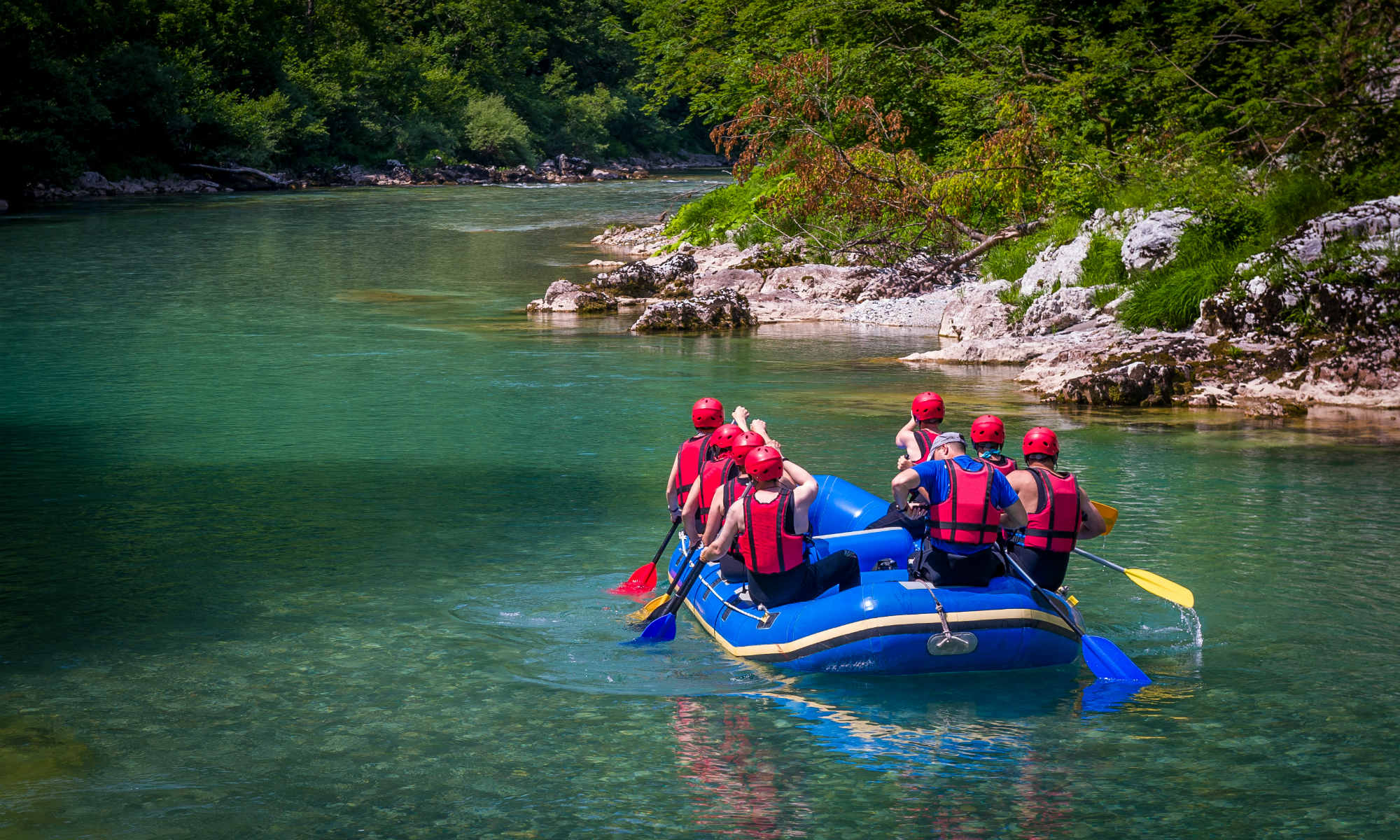
The Tara River, which originates in the Žijevo mountains close to the Albanian border is the longest river in Montenegro. It winds itself all the way through the country until it flows into the Piva River close to the Bosnian border. As the river has, over centuries, carved out the largest and deepest canyon in Europe – the Tara Canyon – it is the perfect place to experience white water rafting in Montenegro. In fact, part of it has been named a UNESCO World Heritage Site due to its unique natural beauty. Hence, white water rafting on the Tara River is more than worth it.
While the Tara River is suitable for all skill levels, groups hoping to have a more adventurous tour should try and plan their trip to go white water rafting in Montenegro either in May or in early June. When water levels drop in July, August and September, families with members of all age groups can enjoy calmer rapids along this blissful paradise for white water rafting in Montenegro. The river can be split into two sections – the upper part and the lower part. For rafting tours on the upper part, the starting point is usually in Splaviste, in the Durmitor National Park. When it comes to the lower part, white water rafting tours start in Brstanovica where the World Rafting Championships took place in 2009.
White water rafting in France
White water rafting in Verdon
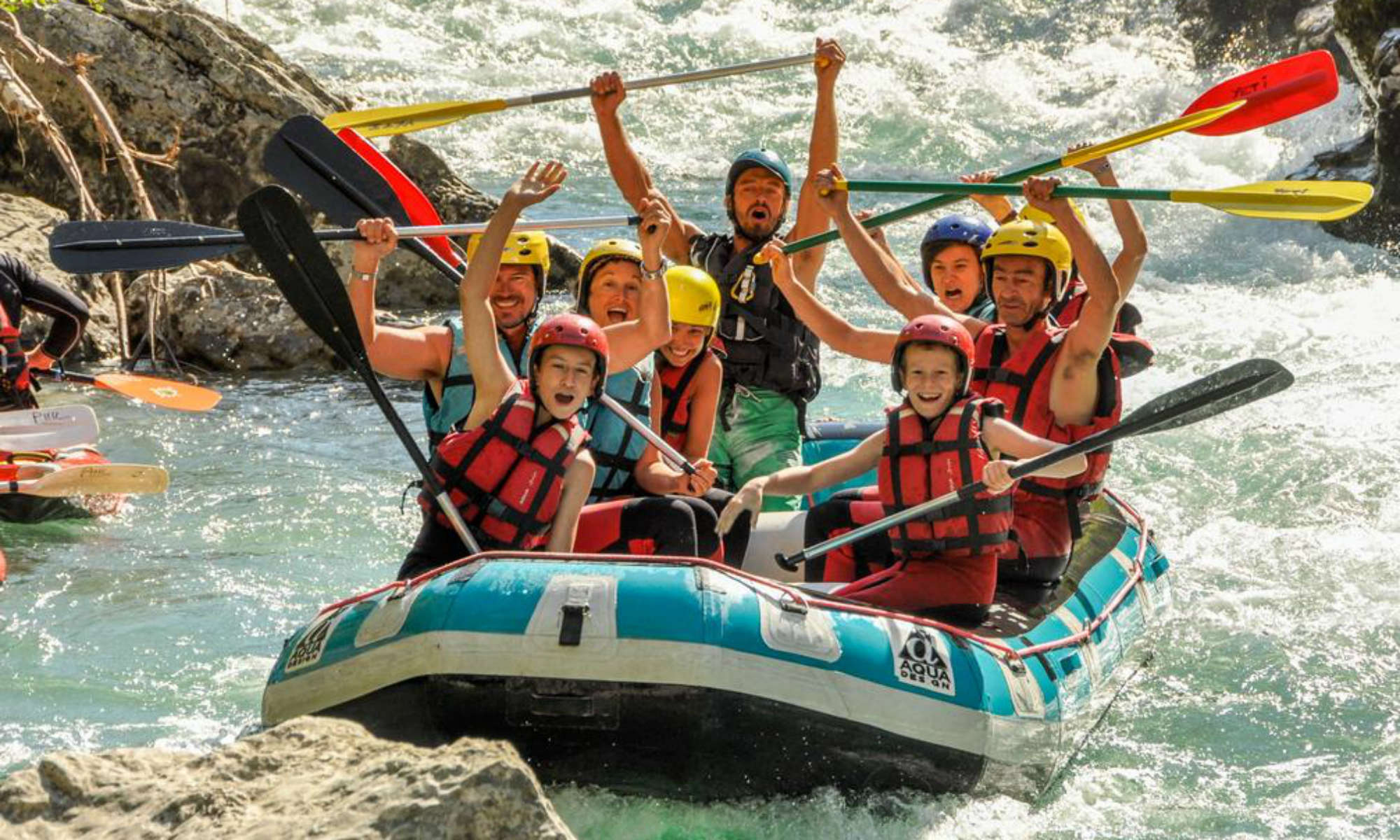
The best place to go white water rafting in France is the Verdon River. It is located in the Provence region of southern France and can be reached in 2.5 hours from Nice and Marseille. The base camps of the rafting providers in the Verdon are located in Castellane. The extraordinary colour of the river, after which it was named, makes white water rafting in Verdon even more special. The Verdon has three sections that can be used to go white water rafting in France and which are of particular interest to tourists, nature-lovers and outdoor enthusiasts. These are the Gorges du Verdon, the stretch from Castellane to the Galetas bridge and the Sainte-Croix artificial lake. The Verdon is definitely the most famous river for white water rafting in France and its grades of difficulty range from II to IV.
White water rafting in Chamonix
The town of Chamonix in the Upper Savoy region is famous for being a top-notch ski resort. Nonetheless, it is also a popular destination to go white water rafting in France. This is due to the tumultuous rapids of the Arve River, which originates here and which winds its way through the entire Upper Savoy region until it flows into Lake Geneva. Since it is fed by a large number of mountain streams, the Arve is one of the most water-abundant rivers in the country, thereby making it ideal for white water rafting in Chamonix.
As a matter of fact, the nature of the river allows for particularly large groups of 20 people or more to go white water rafting in Chamonix. It is, therefore, a perfect activity for company outings, family reunions, or weekend trips with friends. Moreover, in terms of difficulty, its grade II to III rapids mean that it is not too much of a challenge for those planning on going white water rafting in France for the first time. And to top it all off, white water rafting in Chamonix comes with amazing views of the majestic Mont Blanc – making it an even more memorable experience.
White water rafting in Spain
White water rafting in the Pyrenees
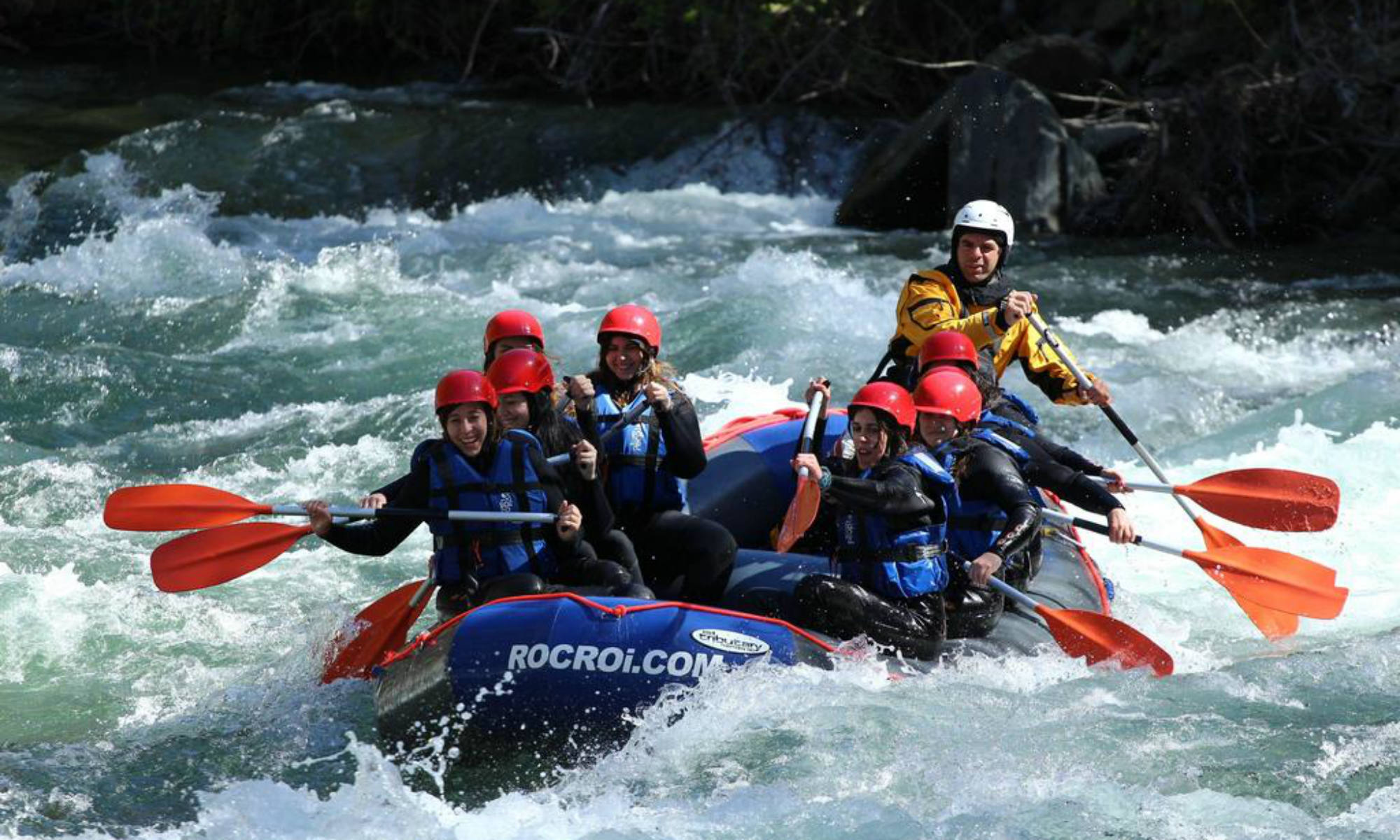
The mountainous landscape of the Pyrenees is undoubtedly one of the best places to go white water rafting in Spain, due to its large variety of canyons and reliable supplies of water. The Noguera River is arguably one of the most popular rivers to go white water rafting in the Pyrenees. It flows through the Catalan part of the mountain range and has an over 50 km long stretch that allows for all types of tours that make for great white water rafting in the Pyrenees – from easy to more challenging.
A particular highlight along the Noguera River, or ‘Noguera Pallaresa’ as it is referred to by locals, is the ‘Quatre llarg’, one of the world’s longest rapids which promises a thrilling rush to those who are looking to enjoy some white water rafting in Spain. Starting points for many rafting tours on the Noguera River are at Llavorsí, or further downstream at Baro.
Further to the East, in Aragon, the Río Gállego River is another hot tip for people planning on booking a trip to go white water rafting in Spain. This river, which flows southwards from the French border and which joins the Ebro river near Zaragoza is characterised by its especially high waves. Indeed there is a zone along the river that is classed IV in terms of its difficulty level. However, there are also easier sections that can be conquered by younger, more inexperienced white water rafting fans. Participants of a rafting tour on the Río Gállego will generally board their raft at Murillo de Gállego.
White water rafting in Switzerland
White water rafting in Interlaken
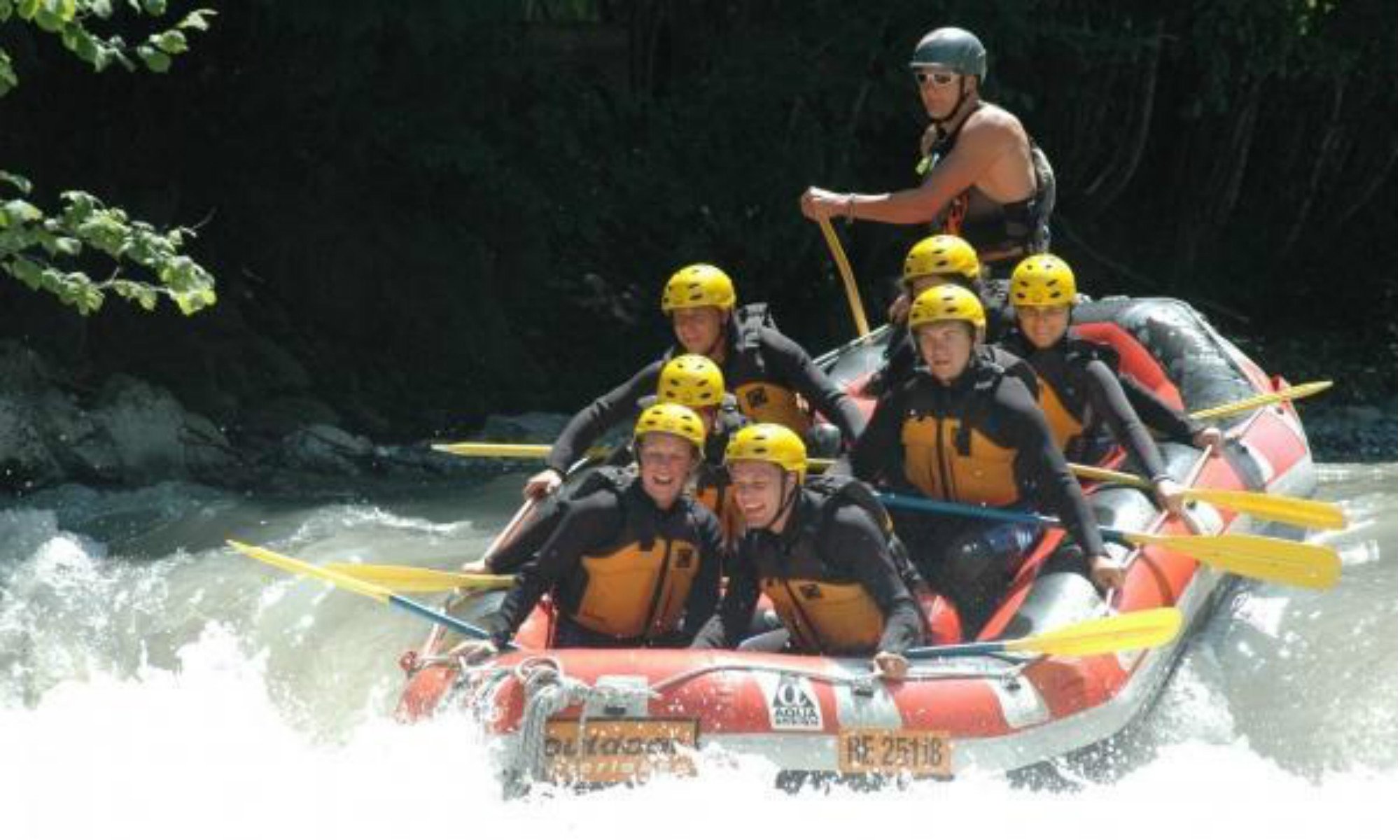
The town of Interlaken in the Canton of Bern is an absolute hotspot for white water rafting in Switzerland. The rivers Simme, Lütschine and Aare stand out, not only because of their beauty and the stunning mountain panorama surrounding them but also because they make for a memorable rafting experience for people of all experience levels. The lower part of the Lütschine is particularly suitable for beginners as well as for families with kids. Other parts of the river, on the other hand, are made up of grade III to IV rapids, which is ideal for anyone who likes an adrenaline rush when white water rafting in Interlaken. Some tours can even be combined with with a quick dip in Lake Brienz.
White water rafting in Graubünden
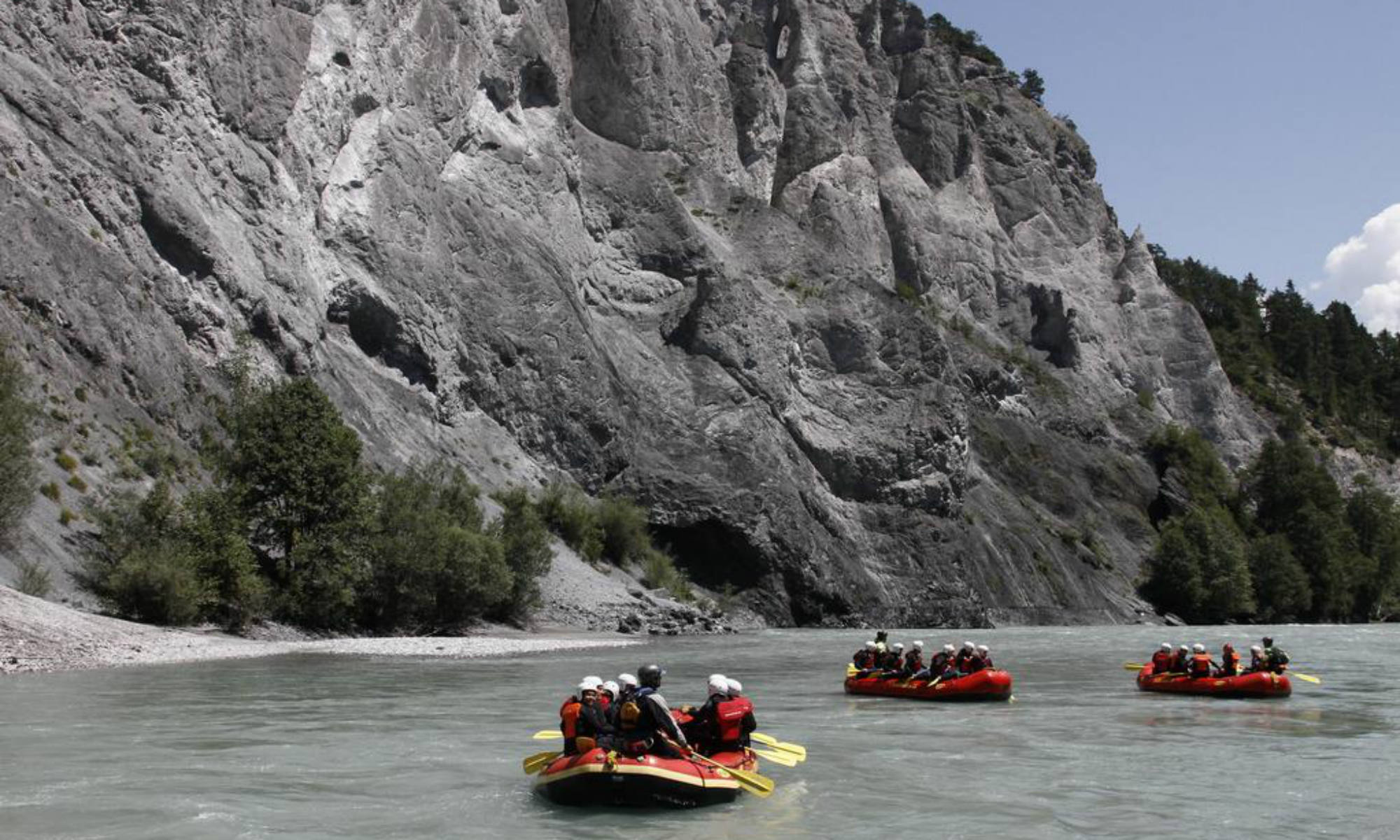
The Vorderrhein (or Anterior Rhine) is bedded in the extraordinary Rhine Gorge, which is known far beyond the country’s borders as the ‘Grand Canyon of Switzerland’. Here, rafters are bound to experience some serious white water action. Indeed, white water rafting in Graubünden has a long history and the respective sections of the Vorderrhein are amongst the first legally approved rafting routes in the country. For most tours, the meeting point is in the small town of Ilanz, which can easily be reached by train.
White water rafting in Austria
White water rafting in the Oetztal Valley
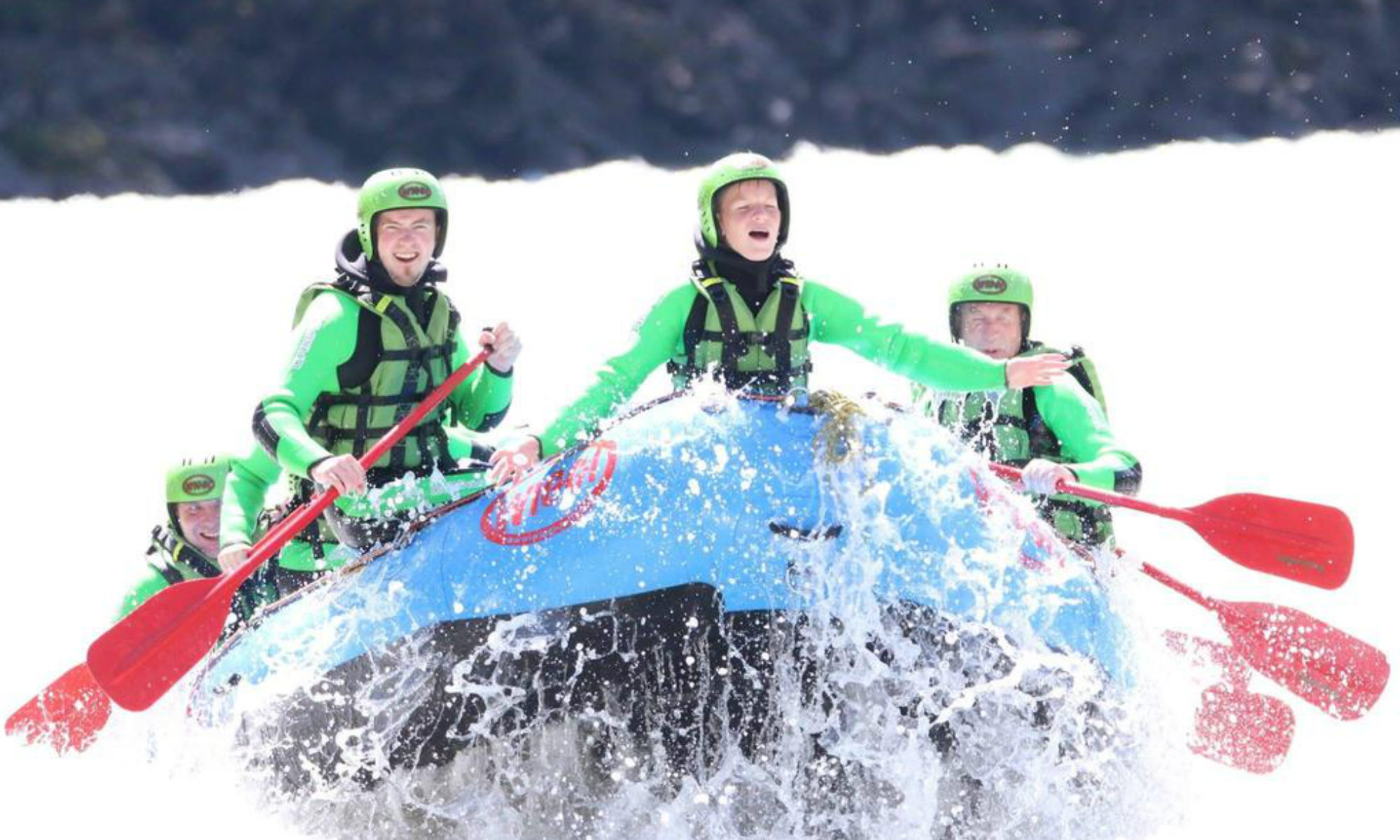
The Oetztal Valley is not only a winter sports paradise, it is, in fact, also a popular destination to go white water rafting in Austria. Due to meltwater from the surrounding mountains, the Inn River and its tributaries boast perfect conditions for white water rafting tours. Particularly the Imst Gorge and the Oetztaler Ache are favoured amongst those who enjoy white water rafting in the Oetztal Valley. Most rafting providers’ meeting points are located in the villages of Haiming or in Sautens.
White water rafting in Styria
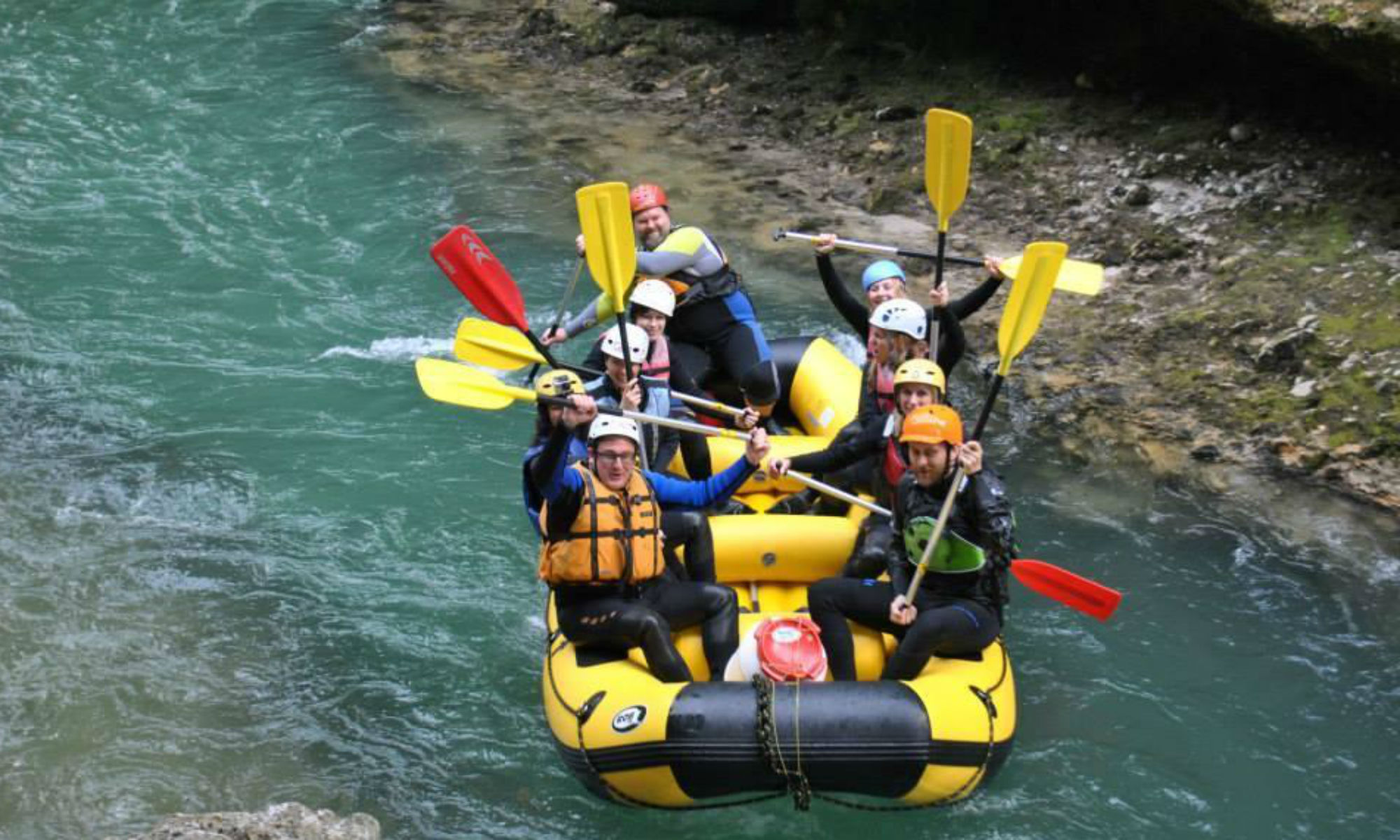
Besides numerous other outdoor activities that can be experienced in the so-called ‘Green Heart of Austria’, white water rafting in Styria is in exceptionally high demand. Indeed, the Gesäuse National Park is considered to be a true hotspot for white water rafting in Styria. The confluence of the rivers Enns and Salza causes the waters to whirl up at an impressive rate, thereby making any white water enthusiast’s heart beat faster. The water of the Salza River takes on astonishing colours ranging from turquoise to emerald green, whereby it becomes a true gem and a popular hotspot for white water rafting in Austria. The villages of Palfau and Landl in the district of Liezen serve as the meeting points for rafting tours on the Salza River. Wildalpen is another departure point for rafting tours on both rivers, while some white water rafting tours on the River Enns also start in Johnsbach, which is part of the village of Admont.
White water rafting in Salzburg
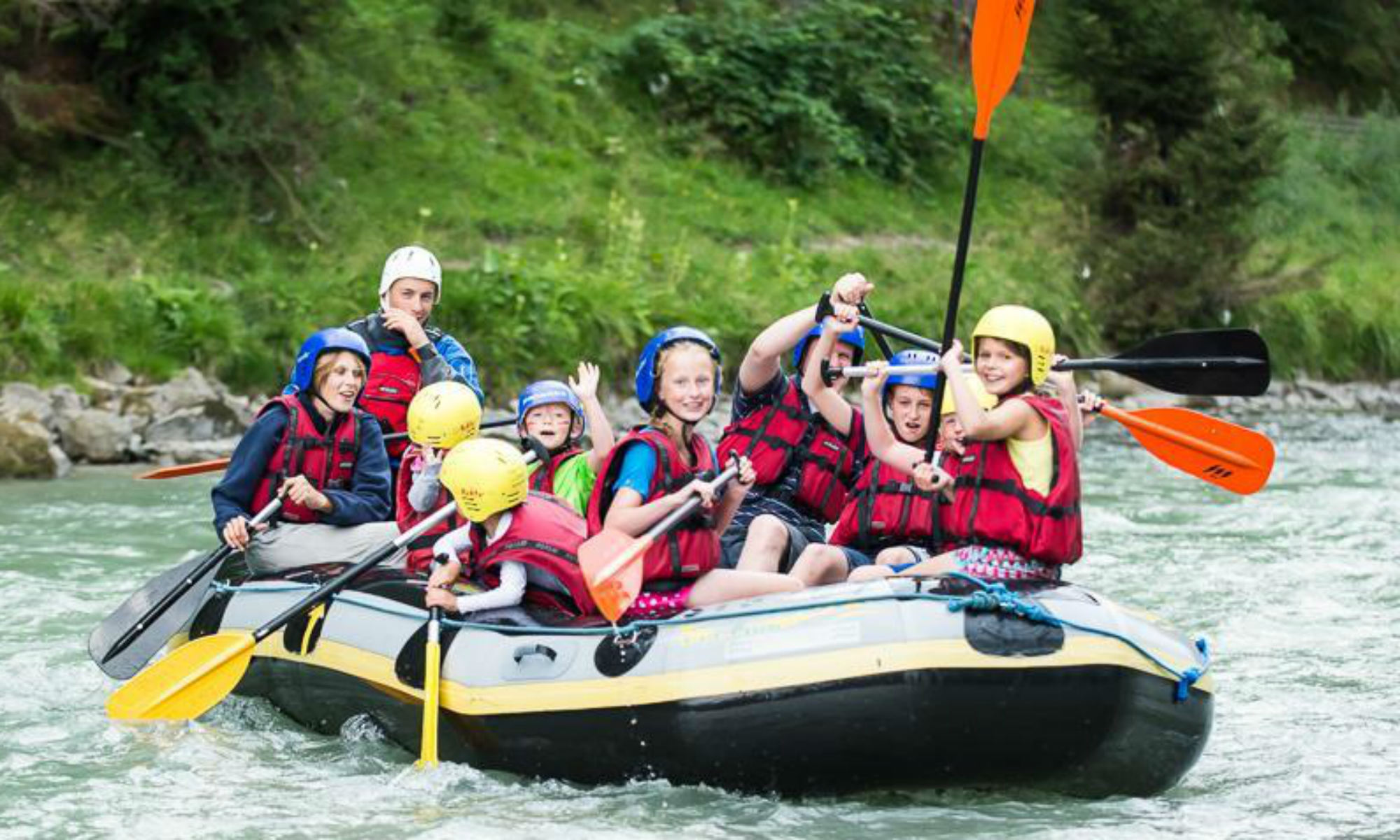
The Austrian federal state of Salzburg is known for being an ideal destination for winter sports fans. Nonetheless, Salzburg also attracts adventurers in large numbers who flock to the state during the summer months to go white water rafting in Austria. While families and beginners can make use of the easier sections along the Saalach River, those who want more of an adrenaline kick can look forward to the rousing waves and the tumultuous rapids of the Salzach River. This river is not only the longest in the Salzburg region but also offers action and excitement for everyone who has dreamt of white water rafting in Austria. The providers typically start their tours on the Saalach River in the towns of Lofer or Zell am See. Meeting points for white water rafting tours on the Salzach River are mostly in Taxenbach, Golling and Zell am See.
White water rafting in Italy
White water rafting in the Val di Sole
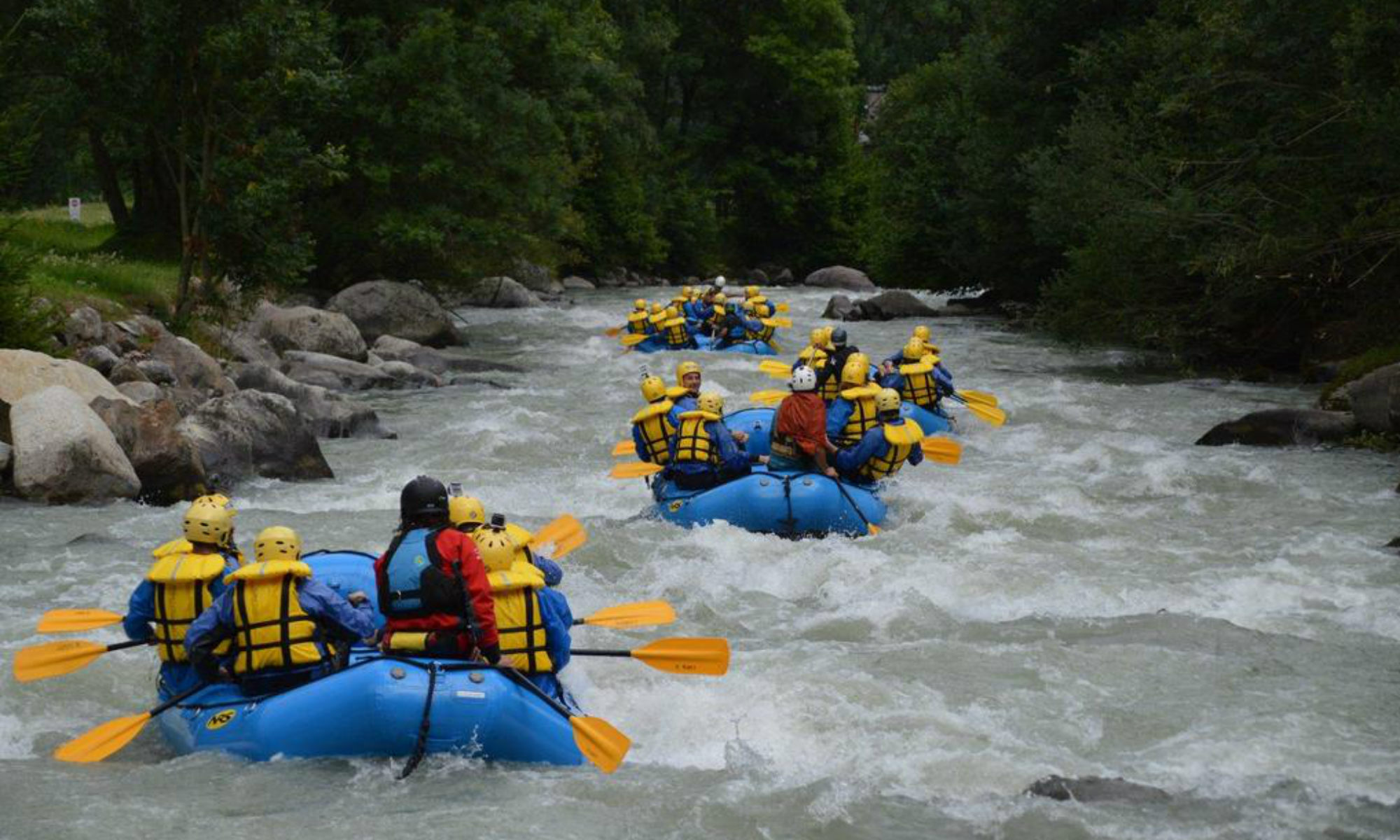
Val di Sole lies in the northern part of the province of Trentino and is a beloved destination within the white water rafting scene. As a matter of fact, the Noce River was the only European river to make the list of National Geographic’s top 10 rivers in the world by placing 9th, thereby making it the best river for white water rafting in Europe. When white water rafting in the Val di Sole, around 26 km of the 105 km long Noce River can be explored by raft. The best time to go rafting on the Noce River is from the beginning of May to the end of September. During this period of time, the river is supplied with water from a number of glaciers and water levels are consistently high. Starting points for rafting tours on the Noce River are, for example, in Commezzadura and in Mezzana.
White water rafting in Umbria
The most popular place to go white water rafting in Umbria is around the man-made waterfall Cascata delle Marmore, which is also the highest waterfall in Italy. The waterfall flows into the Nera River, the largest tributary of the Tiber River, which is relatively calm and therefore ideal for a beginners’ rafting tour. With a level of difficulty of grade I, the Nera River belongs to the easiest rivers for people to go white water rafting in Italy. As such, even families with young children can easily explore the river.
What does a typical white water rafting tour look like?

The rafting providers’ meeting points can usually be found directly at, or in close proximity to the starting point of the respective white water rafting tour. Depending on the provider, participants either travel from the base camp to the entry point of the river by car or on a shuttle bus. Before the adventure begins, members of the tour are given all the necessary equipment.
In order to ensure maximum safety throughout the tour, all participants are briefed by a certified and experienced rafting guide. Beside informing everyone about the necessary safety precautions, the guide details the exact course of events of the rafting tour and tries to clarify any questions participants may have. Together, everyone practises the right paddling technique and how to properly handle the raft. In most cases, the guides also carry a first aid kit, a mobile phone and a throw bag so as to be able to act quickly in case of an emergency. After the safety briefing is completed, nothing else stands in the way of some unforgettable white water rafting fun. With the help of the rafting guide, participants attempt to master the rapids of the white water river. Since everyone is – quite literally – in the same boat, team spirit is a very important part of every rafting tour.
At the end of the rafting tour, all participants are brought back to the entry point where they have parked their cars or where the shuttle bus is waiting. Once everyone has been transferred back to the base camp, participants can make use of the facilities to have a warm shower and change into a spare set of clothes. Many providers’ base camps have their own bar or restaurant where people can have something to eat or drink and where they can relax after an exhausting day out on their boats. Oftentimes, the providers also offer barbecues as a way to close out the whole rafting adventure in style.
Which equipment is needed to go rafting?

The great thing about rafting is that there is no need to bring along any equipment, wherefore it is an ideal activity for holidaymakers who are looking for some exciting white water fun in their respective holiday destinations. Next, to the rubber dinghies and the paddles, providers have all the necessary equipment on site, including wetsuits, neoprene socks, life jackets and helmets, so that participants don’t need to worry about bringing anything. The equipment is serviced and cleaned regularly so as to ensure it is always in good condition.
What to wear on a white water rafting tour?
All anyone has to bring along to a rafting tour in terms of clothing is the swimwear they wish to wear underneath their wetsuit as well as a pair of trainers they don’t mind getting wet. In addition, people are advised to bring along towels, shower utensils, sun cream, and a spare change of clothes. Since the neoprene socks that come with the wetsuit are quite thick, it’s a good idea to bring along loose-fitting shoes to go white water rafting.
Safety first – what to pay attention to when rafting?
White water rafting takes people on a spectacular voyage over rousing waves, past numerous rocks and other natural hurdles, and along thrilling rapids. Depending on the water level and the river’s grade of difficulty, tours can either be more or less challenging. Since getting wet is part of the whole fun, white water rafting tours usually take place even when it rains. As long as there is no hail and no thunderstorm, the weather is not much of a factor when it comes to safety.
To avoid anyone feeling unsafe and to make sure nobody puts him or herself in danger while out rafting, there is a detailed safety briefing before every tour which is carried out by the rafting guide. He or she explains how to properly handle the boat, how to use the paddle, and how to behave in unexpected situations – for example if the boat capsizes. Only once everyone’s questions have been answered and everyone feels confident enough to go out onto the water, the boat is carried to the river.
Before embarking on a rafting adventure, all participants must declare that they are physically and mentally fit to take part in the tour. This is mostly done in written form. Any illnesses, such as asthma, epilepsy or diabetes must be disclosed beforehand so that the guide can act accordingly in case of an emergency. It is also important that the rafting guide is informed about any allergies in connection with plants or animals, as white water rafting is an outdoor activity. If participants take any kind of medication such as asthma sprays or allergy tablets, they should definitely bring them along to the rafting tour.
For me, skiing is the perfect combination of spending time with family and friends, exercise, and outdoor bliss. What more would you want?

